The Moliceiro Boat is, more than a traditional boat, one of the main elements of the cultural identity of the Aveiro region, with a rich history deeply rooted in local tradition.
Whoever visits the Ria de Aveiro will certainly not be indifferent to its panels’ humor and structure, which are entirely different from the boats that sail here. Getting to know the history of the Moliceiro Boat and its construction process is to enter the most intimate part of Aveiro’s culture.
Learn more about the traditional Moliceiro boat
Sailing through the history of the Moliceiro Boat
The Moliceiro Boat is a traditional vessel that exists and navigates exclusively in the Ria de Aveiro, created from scratch by the region’s master shipbuilders in the 19th century. At that time, the collection of “moliço” in the Ria de Aveiro – which served as fertilizer for agricultural lands – was one of the thriving economic activities, requiring the creation of a boat to facilitate this work.
In this context, the shipbuilders of the region constructed a new vessel from scratch, which they named the Moliceiro. Through several adaptations to its structure, it facilitated work on board. It allowed people to sleep at the boat’s bow, as it was common for workers not to return home for several days. Additionally, the Moliceiro was built with a shallow draft to ensure it could navigate the shallow waters of the Ria de Aveiro without running aground.
The success of the new vessel was such that the Ria de Aveiro started to be navigated daily by hundreds of Moliceiro Boats, turning the “moliço” collection into one of the leading employment activities in the region. As agricultural processes evolved, people abandoned the moliço collection in the Ria de Aveiro and sought other jobs (or emigrated). However, the Moliceiro Boat had already become a symbol of the region, and even though it was no longer needed for the moliço collection, it continued to be built by the region’s master craftsmen.
Today, it is one of the main tourist attractions of the Aveiro Region. But there is much more to discover. Don’t limit yourself to boat rides!
This beautiful boat is useful for everything (...) it is the delight of the ria. It has something of a bird and a theatrical composition. It enhances the landscape (...) it even serves as a house (...) I do not know any other boat more artistic, lighter, more adequate to the functions it performs and to the landscape that surrounds it.
Raúl Brandão, 1923, in “Os Pescadores”
Did you know?
The Art of Naval Carpentry of the Moliceiro Boat is a candidate to UNESCO World Heritage?
After the registration in the National Inventory of the Intangible Cultural Heritage, in 2022, the Intermunicipal Community of Aveiro Region – the entity responsible for the process – submitted, in March 2023, the application “Moliceiro Boat: Naval Carpentry Art of the Aveiro Region” to the List of Intangible Cultural Heritage in Need of Urgent Safeguarding – UNESCO.
The traditional art of naval carpentry in the Aveiro region
Moliceiro, an art of passionate people
When talking to people from the region about the Moliceiro Boat you will see that there is a special feeling. Many will tell you that it is passion. You will probably ask yourself: “Is it possible to love a boat?”, but we assure you that this is exactly what happens in the Aveiro region.
The best way to get to know this feeling is to get in touch with the master shipbuilders. Yes, in Aveiro region we call the boat builders of Moliceiros “Master” as a form of recognition for their wisdom.
4 things you really have to know when visiting a shipyard
We suggest that you visit one of the shipyards that exist in the Aveiro region. Talk to the Masters and understand how the moliceiros boats are built and learn about the main tools used.
You cannot end your visit without knowing:
- What is a “Pau-de-Pontos” and how it is used.
- What a “cavilha” is, and how it is made.
- What is the master’s symbol/brand.
- What is the “Bota-abaixo” and when does it happen.
Did you know?
The Moliceiro Boat is the only boat in the world with 4 decorative panels (2 on the bow and 2 on the stern), and they all have different drawings and captions?
In addition, the panels of the Moliceiros’ boats are repainted every year, always with new drawings and captions that allude to current themes, expressing the thoughts of the community and the main moments of that year. At the Monte Branco Shipyard-Museum, you can observe the evolution of the decorative panels and understand how the local community developed.
A controversial and feature element
Why do decorative panels exist on Moliceiros’ boats?
This is one of the most frequently asked questions by those who visit the Aveiro Region. The moliceiros panels are one of the elements that stand out the most for their humour and colours.
However, there is not a 100% correct answer. It is known that the Moliceiro are the only boat in the Ria de Aveiro with decorative panels (with drawings and captions that complement each other) and that this tradition has always existed since there was a record.
Some believe that the paintings appeared to embellish the boat. As the Moliceiros were considered a home for the workers of the harvest (who slept and ate there for several weeks without going home), they started to paint the bow and stern panels to make the moliceiros more pleasant and a source of pride for those who worked on them.
Some people argue that the decorative panels served to identify the boats. At a time when people had little (or no) schooling, the drawings ensured that the boat was more quickly identified by the buyers of seaweed.
Regardless of their origin, the moliceiros panels are today one of the main tourist attractions of the Aveiro Region, which you can’t miss on your visit. Walk along the Ria de Aveiro and explore the countless moliceiros’ existing panels (we’re sure you’ll be surprised by their quality, humour, and message!)
Not to be missed in Aveiro Region
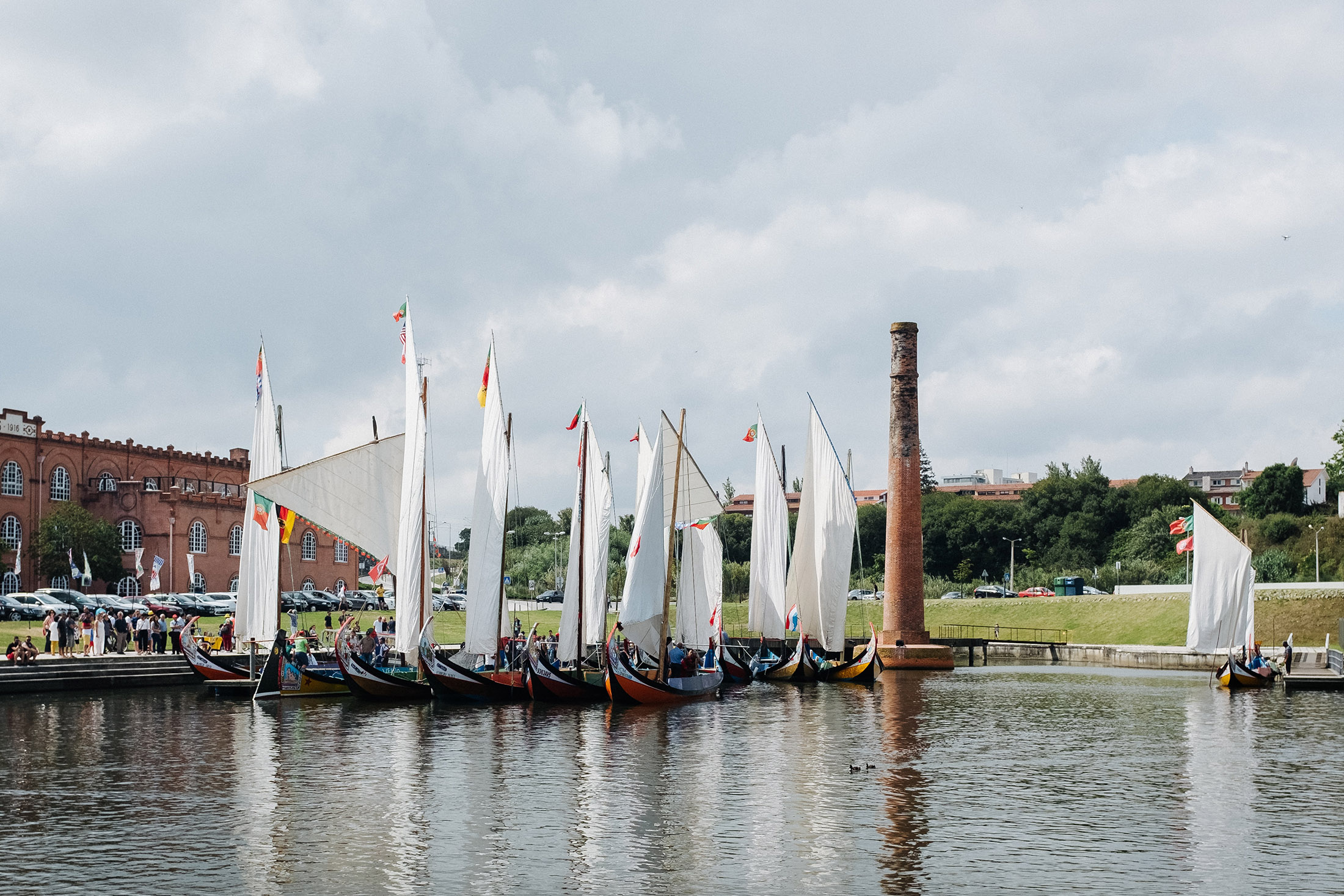
Moliceiros’ Regattas
This is one of the main traditions of the Ria de Aveiro, which attracts thousands of people every year – residents, curious people and tourists – to its banks, to watch the moliceiro boat regattas. These are unique and unmissable moments due to the competitiveness among the participants and due to the scenic beauty of the moliceiro boat sailing on the Ria de Aveiro.
We recommend a visit to Aveiro Region in the days which precede the regattas so that you may also live the preparations which range from last minute repairs to the painting of the panels by the master-painter José Manuel de Oliveira. You won’t regret it.

Monte Branco Shipyard-Museum
At Monte Branco Beach, in the municipality of Murtosa, you can find one of the main attractions not to be missed in the Aveiro Region. The Monte Branco Shipyard-Museum is a place that combines the museological space about the history of the Moliceiro boat with the live work of naval construction by Master José Rito.
Start your visit to the museum, where you can find out details of the history of the harvesting of the moliço and shipbuilding, as well as the tools used and the techniques. Then, right next door, visit the shipyard of Master José Rito and get to know the master himself. This is where he works every day and builds the moliceiro boats. A unique experience!

Ria Room – Maritime Museum of Ílhavo
If you want to take your visit further, you really must see the Maritime Museum of Ílhavo and, especially, the Ria Room.
This is a space where you can find life-size replicas, built by Master António Esteves, of the traditional vessels of the Ria de Aveiro. Discover the main boats which, in addition to the Moliceiro Boat, are characteristic of our Region.
You will also be able to see the collection of various master shipbuilders and painters of the region. A visit that should not be missed.
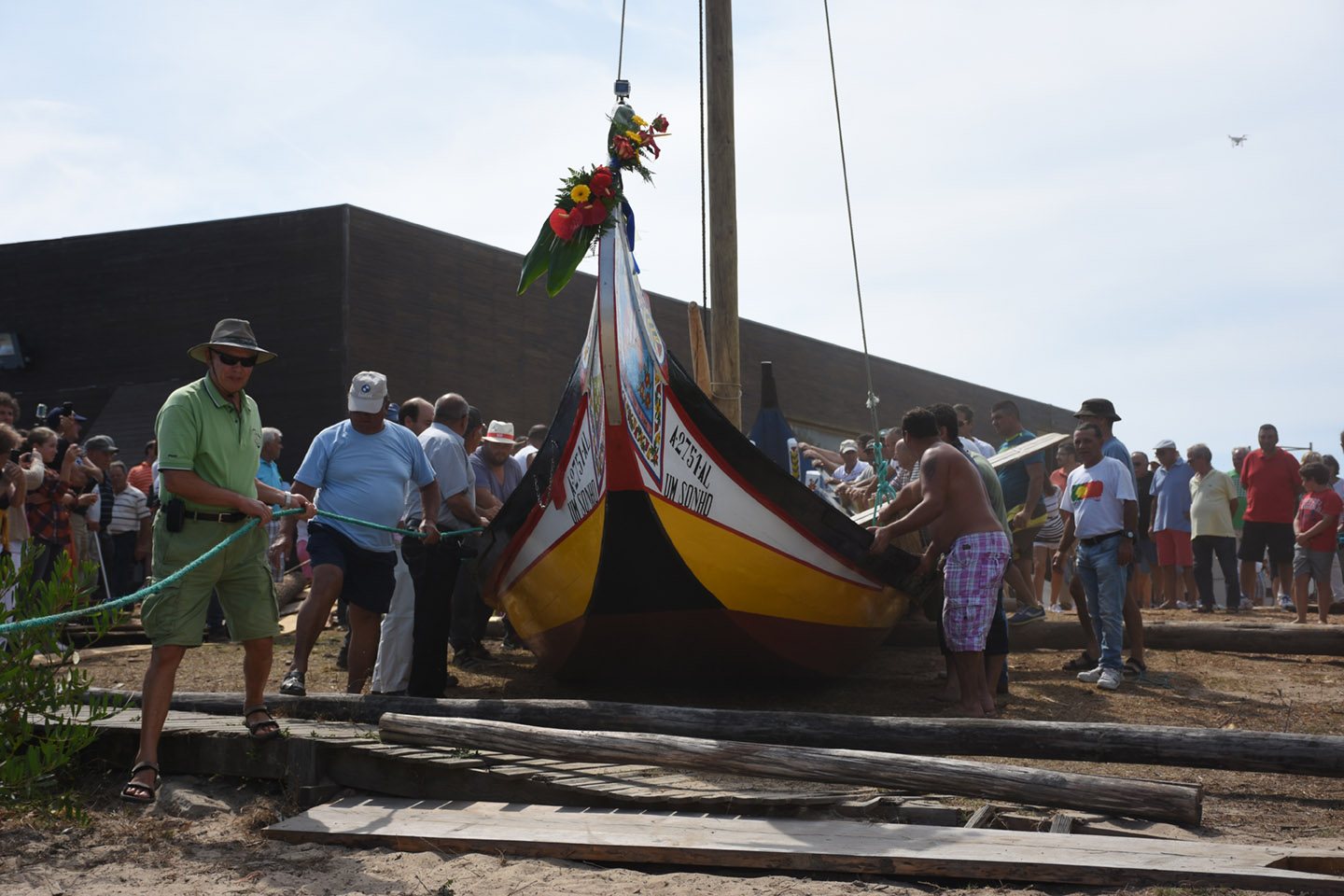
Bota-Abaixo
The end of the construction of a moliceiro boat is, for several decades, synonymous with celebration! The day when the boat is launched into the water for the first time (known in the Aveiro Region as “Bota-Abaixo”) is a moment that gathers several people near the Ria to help in the task or simply to watch this moment.
It is a moment of great emotion for the builder and the owner. In Bota-Abaixo, several traditions (rituals) are performed to “bring luck” to the boat.
If you are in the Region on one of these days, we suggest you add “Bota-Abaixo” to your list. Participating in a Bota-Abaixo will allow you to understand the sentimental value of the Moliceiro Boat for the people of the Aveiro Region.
Get to know the Masters
Your visit to the Aveiro Region will not be complete without exploring the history of the Moliceiro Boat and learning about its construction and decoration process.
Currently, there are only 5 master builders and 1 painter of moliceiros who keep this tradition alive. The Art of Naval Carpentry, practiced by these craftsmen, is, since 2022, considered Portuguese intangible heritage and is in the process of being nominated for UNESCO intangible heritage of Humanity.
Get to know our masters and discover all the history and specificities of the construction of the Moliceiro boat.
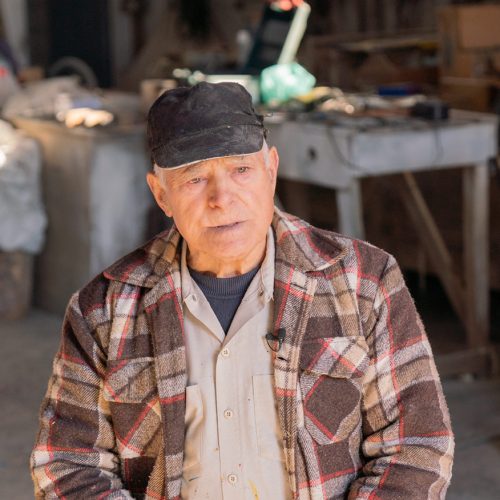
António Esteves (b.1942), known as Pardaleiro, is the oldest active master builder working in the art of naval carpentry of the moliceiros. His shipyard is located in Pardilhó.
He began working at age 10 in the shipyard of Master Henrique Lavoura, one of the main master builders of the Aveiro region, where he stayed until he emigrated to the United States of America. He returned to Portugal in 1993, dedicating himself to the art of shipbuilding until today. During this period, he has already built dozens of “Moliceiros” and several other traditional boats of the Ria de Aveiro.
Talking to Master António Esteves is a unique experience that will make you explore the region’s history and the Moliceiro boat.

Better known as Zé Rito (b. 1956), he is the only master builder that also worked in harvesting moliço, starting at the age of 7, accompanying his father and brother. At the age of 28, he began repairing boats, motivated by Master Manuel Raimundo, who taught him the Art of Naval Carpentry. Until today, he has built about two dozen moliceiros.
Since 2010, Master José Rito has been performing his art at the Shipyard-Museum of Monte Branco Beach, owned by the Murtosa Municipality. This space intends to promote and value this art, becoming a living museum of this heritage where everyone can visit and watch the construction of the traditional boats of the region.
When you visit the Monte Branco Shipyard Museum, you will be able to witness the work of Master José Rito and learn about the region’s history and the moliceiro boat in the exhibition space.
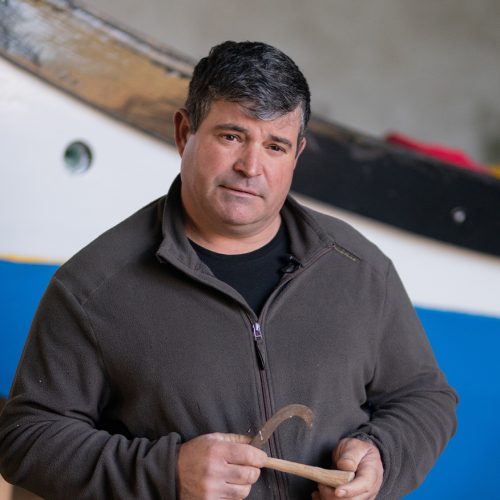
Master Marco Silva (b.1975) is the youngest to work in the art of naval carpentry of the moliceiros boats. He recalls “growing up with his feet in the water” and that “ever since he was a child, he remembers boating in the ria.”
After a period of emigration, he began to participate in the Moliceiros Regattas with an acquired boat. In 2015, he built his own moliceiro boat, with the help of Master Firmino Tavares, using the traditional technique.
Only since then did he dedicate himself to the naval construction of traditional boats, building until today about a dozen moliceiros boats until today.
Besides shipbuilding, Marco Silva dedicates himself to the Xávega Art, two of his main passions.

Master Felisberto Amador (b.1959) learned the art of naval carpentry in the shipyard of Master Henrique Lavoura, one of the main master builders of the Aveiro region, starting to work at the age of 14. After the military period, he returned to Pardilhó and dedicated himself exclusively to constructing Moliceiros boats. Since the ’80s, he estimates to have built more than two dozen moliceiros.
It is very frequent to find Master Felisberto Amador working in Ribeira de Nacinho, where he repairs the Moliceiros’ boats. Talking to him, you will understand not only the details of the boat’s construction but also the priorities of the repairs and maintenance that must be done every year.

Master Arménio Almeida (b.1958) also started his apprenticeship in the shipyard of Master Henrique Lavoura at the age of 11. Henrique Lavoura was his uncle and was the main driving force for him to “gain a taste for the art.” He continued to work at the shipyard until it closed in 1983. Mestre Almeida then worked with Master Felisberto Amador and Master António Esteves, working independently since 2002. Currently, he dedicates himself to boat repairs and the construction of bateiras.
In 2023, he was the responsible trainer for the professional course on Naval Carpentry that took place in the Centro de Interpretação da Construção Naval, in Ribeira d’Aldeia, Pardilhó, which had the main goal of ensuring the transmission of knowhow to new generations.
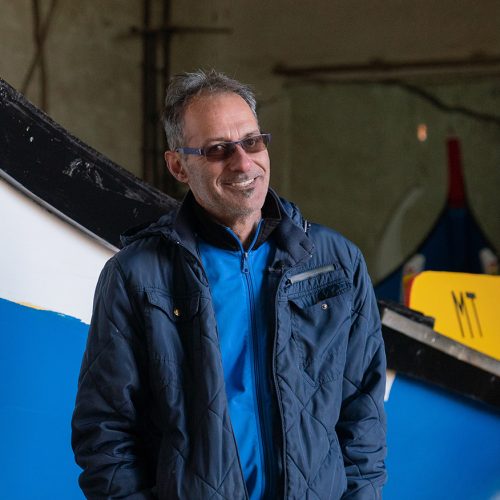
José Manuel Oliveira started painting moliceiros in 1989, at a time when the death of Jacinto Lavadeiro and the advanced age of Avelino Marcela, the two main painters of moliceiros at that time, “forced” the builders and owners of moliceiros to look for new artists. Nowadays, he is the only active painter of moliceiros in the Aveiro region, having painted more than 1000 panels in the last 30 years.
For the painting of the panels, his inspiration comes from living by the river, contact with the community, and daily life in the shipyards. He doesn’t have a fixed place to do his work, moving around the Ria, depending on the work to be done – both in shipyards and on the waterfront.
In the weeks before the moliceiros’ regattas, when you go along the banks of the Ria de Aveiro, you will probably find José Manuel Oliveira repainting the panels of the moliceiros’ boats, and you will be able to watch his creation live.


